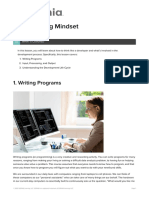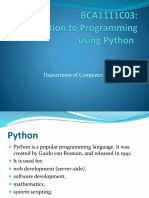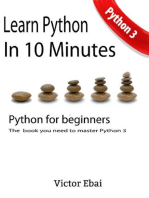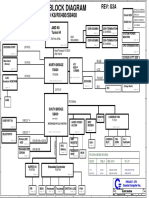03-Dan Turda A4
03-Dan Turda A4
Uploaded by
MephistoCopyright:
Available Formats
03-Dan Turda A4
03-Dan Turda A4
Uploaded by
MephistoOriginal Title
Copyright
Available Formats
Share this document
Did you find this document useful?
Is this content inappropriate?
Copyright:
Available Formats
03-Dan Turda A4
03-Dan Turda A4
Uploaded by
MephistoCopyright:
Available Formats
Computational Civil Engineering 2005, International Symposium
Iai, Romnia, May 27, 2005
Python is a C++ made easy for Civil Engineers
Dan V. Turda (Ph.D.)1, F.-Zsongor Gobesz (Ph.D.)2
1
Chair of Structural Mechanics, Technical University of Cluj, Cluj-Napoca, 400020, Romania
Chair of Structural Mechanics, Technical University of Cluj, Cluj-Napoca, 400020, Romania
Summary
There exists an issue on the teaching of the programming, when non-programmers
are the subject. It is, in our opinion, the "appeal to programming" which should be
the "corner stone" a teacher should find. Python is a very modern programming
language, interpreted, very fast, built as a C++ wrapper having a Pascal-like
syntax. When it is used with specific libraries, like wxPython, SciPy or vtkPython,
it becomes a very powerfull tool in developping even professional engineering
applications. Not only there is the ease of programming, but also it transforms
programming in a pleasure. Moreover, py2exe can transform any interpreted
Python code in a MS-Windows .exe, by translating in C++ code and doing native
compilation. We like FORTRAN, but we really love Python. Here is our motivation,
along with examples.
KEYWORDS: teaching, programming, civil, engineer, python, C++ .
1. INTRODUCTION
Civil Engineers are often put in situations when hand-calculus is too complicated,
even if a pocket calculator would be available. From on-site situations up to
designing in short term, making its own program could solve the problem.
While we recognize the tradition of FORTRAN, we have to advocate our
conviction that we are talking about a lost tradition. The original FORTRAN was
conceived under the concept of "structure of procedures". It was added a support
for "structure of data", but the separation between data and statements was
rigorously respected. One can remark the position of COMMON or EQUIVALENT
blocks in a FORTRAN program.
We have to remark that at the time when FORTRAN was the only scientific
programming language, a compiler had to fight hard restrictions. Beyond
the processor's speed, it was the amount of RAM (Random Access Memory)
available for a program. Some of us remember how the trepassing from
FELIX-256 to FELIX-1024 was seen as a "big step forward". Yes, upgrading
D.V. Turda, F.Zs. Gobesz
from 256kb of RAM to 1Mb RAM was an important step. We do not realize
now, when a single no-name PC can have 512Mb, how our "ancestors"
could solve heavy problems. FORTRAN was the answer of the time.
However, this language remain the fastest under any comparison, and use
the smallest memory spot.
While reconigsing the merits of the old FORTRAN (upto FORTRAN77), we
have the right that the new versions of FORTRAN (from FORTRAN90),
denaturate the principles of the original concept. One cannot say that a new
language is born, and that should have another name! We have no more
FORTRAN. We get compilers with a payed license for which the learning
curve is very long. The learning process exclude organigrams as the starting
point in teaching Logic Mathematics and Boolean Algebra. This exclusion
make many students to put an inocent question: "What for we have to learn
that?". And this question is a ultimate one for a teacher.
2. OBJECTS
2.1 The object paradigm
With the advent of modern computers, including network facilities, there is no
more need of such data and statement structures as in the original FORTRAN. Data
and statements are contained (encapsulated) in objects. As a result an object can be
created or deleted, but the gain is that an object can communicate inside the
program (or outside of it) as the object include statements. It appeared also the
Application Interface Programming (API) concept, which allow a programmer to
address or to link to objects already compiled and tested.
The advent of objects is surely not the final point in the evolution of computer
programming, but it was a major "step forward". From a list of hierarchical
structures of data and statements, as in FORTRAN, the new technique approach a
n-dimensional graph. It is not a philosophy here, it is just about changing a point of
view. With care for the inheritance, we have to mention that Python can inherit
FORTRAN programs or libraries.
Guido van Rossum have had a marvellous idea to make a C++ wrapper
using a Pascal-like syntax. Using a strong-typed and objectual approaches,
he wrote a new language. This new language got the name Python, as Guido
like very much the Monty Python film series. The intention, form the very
start, was to make a language very easy to learn, very powerful, and to be in
the position to declare: Do you see how easy is to program a computer? And
Computational Civil Engineering 2005, International Symposium
he had a great succes. He was hired at the main education center in the
United States.
2.2 About the Graphical User Interface (GUI)
The evolution of the personal computers, but also of other devices like the mobile
phones is going in (at least) two directions, namely computation power and a mix
of text and image information.
We, as teachers, know that an image could "worth a thousand of words". We
know that, because any time when it is necessary, we drop a sketch on the
blackboard. However, we are not still able to make dynamic representations.
Moreover, once the blackboard is wipped, we are not able to make back
comparison, unless we redraw the sketch.
From now on, we will call FORTRAN as any version upto FORTRAN77.
FORTRAN is not able to carry GUI programming, nor to have access at
XML parsing, as examples. Graphics are necessary but are not teached. Our
proposal was to use FORTRAN for heavy computation (it is unbeatable!)
and to use Python for GUI programming and for small computation (it is
unbeatable!). As Python can wrap FORTRAN, we could get a swiss tool
instead a single one.
2.3 What we did
We created an experimental tool for teaching some matters in Python. We gave the
name aicSimpleSol to the program, and there is a free download, use and
distribution at http://www.aic.info.ro/ in the "Software" section.
It consist's of a main pannel which contains a tree, from any particular application
can be launched (Figure 1).
Once launched, each new window has three areas, namely the data area, the
graphic area and the help area. The help area use a wxPython widget which allowed
us to right the help text in HTML format (Figure 2).
There is an important feature we had in mind when we designed the program, and
that is the link between data and graphics. That is, any time data change, the
graphic window is updated. At this time, the graphics window is unsensitive, i.e. no
data can be changed using pointing devices (e.g. the mouse). It is not a
disadvantage, as we have to focus on data, and to give the mean to see how a
change in data affect the stress distribution, as an example.
D.V. Turda, F.Zs. Gobesz
Figure 1. aicSimpleSol's main panel
The entire task was possible by using PYTHON in combination with wxPython and
Boa Constructor. wxPython stands for a port of wxWidgets to Python, i.e. the
implemantation of windows, buttons, scrollbars, etc., as elements of a GUI, for
their direct use under PYTHON. Boa Constructor is a powerful tool for editing
PYTHON files and arange GUI elements on a frame.
So, we did a mix. It is the programming, on one hand, and elements of Civil
Engineering disciplines, on the other. Using a laptop and a big screen projector we
can now better explain the matter issues. But this a point of view. Seeing the fact
from another point of view, we succeeded in new concepts and language appraisals.
We know now how to integrate a perfect heavy computation tool (FORTRAN) with
a GUI, with network facilities, with database server access, and with XML
facilities, all platform independent.
After all these gains, we put ourselves, rethorically, a single question: Why not
developing ourselves the tools we need for teaching, just by teaching new
programming languages and not a single one?
Computational Civil Engineering 2005, International Symposium
Figure 2. A launched application.
For anyone curios about how a PYTHON script is looking, we give in Figure 3 a
fragment of the code for the application shown in Figure 2. One can observe that
the syntax is close to the C and C++ programming languages, even if has a very
interesting particularity: the white space is important. That means that the
programmer is obliged to take care of the source layout, as the statements that are
more in-depth are subordinated to the one which is less nested. One can observe
how an if statement is looking like, in the Figure 3.
We underline that all the tools we used are free of charge, and can be downloaded
from INTERNET. This aspect is very important in teaching, as most of the students
have computers at home, or have access to a collegue's one. This mean that we had
been used commercial software, the students could do their homework using only
commercial software. As most of them do not have enough financial support, we
would encourage them to use pirated software. But our mission is to teach for the
good behaviour, not for a bad one. Or this is not a part of our mission?
D.V. Turda, F.Zs. Gobesz
Figure 3. Code fragment in PYTHON
3. CONCLUSIONS
The teaching process is a very complex one. The modern technology offers a wide
range of tools, and we should learn how to use them. We should do so, because the
technological advance is very fast, and there remain only two years or so until
Romania will be part of the European Union. And from than on, will not be a
surprise to hear phrases as "Learning in other EU country is better than in
Romania, even if it a bit more expensive". For that we are preparing!
References
1.
PYTHON, http://www.python.org/.
2.
wxWidgets, http://www.wxwindows.org/.
3.
Boa Constructor, http://www.boa.sourceforge.net/.
You might also like
- High and Low Level LanguagesDocument5 pagesHigh and Low Level LanguagesAhmed HassanNo ratings yet
- Python Book CH1Document5 pagesPython Book CH1Balamurugan HNo ratings yet
- Speech Emotion Recognition and Classification Using Deep LearningDocument39 pagesSpeech Emotion Recognition and Classification Using Deep LearningJohn Cena100% (1)
- Unit - 1 - III Cs - PythonDocument23 pagesUnit - 1 - III Cs - PythonjagethirameshNo ratings yet
- PsychologyDocument33 pagesPsychologyShazia 4843No ratings yet
- A Transition Guide: Python To C++Document28 pagesA Transition Guide: Python To C++Vincent TemboNo ratings yet
- NAVEEEEDDocument82 pagesNAVEEEEDFake AccountNo ratings yet
- Introduction To PythonDocument58 pagesIntroduction To Pythonjainsneha813No ratings yet
- Foundations of Programming Languages Kent D. Lee 2024 Scribd DownloadDocument62 pagesFoundations of Programming Languages Kent D. Lee 2024 Scribd Downloadnaishlevindb100% (2)
- Let Us C++Document14 pagesLet Us C++tameshh43% (7)
- CSC1201 Python ProgrammingDocument33 pagesCSC1201 Python ProgrammingchizpsquareNo ratings yet
- Python Training ReportDocument42 pagesPython Training Reportblossom xNo ratings yet
- CBT Nugget - Python Programming Language NotesDocument95 pagesCBT Nugget - Python Programming Language NotesAbhinavNo ratings yet
- CPP UNIT-IDocument43 pagesCPP UNIT-Ikeshavpatel2287No ratings yet
- Learn Python Programming The Comprehensive Guide To Learn and Apply Python by Learning Coding 2021Document81 pagesLearn Python Programming The Comprehensive Guide To Learn and Apply Python by Learning Coding 2021Percyes_Civilunh100% (3)
- Python 3 Without Pri by Spahic BenjaminDocument98 pagesPython 3 Without Pri by Spahic BenjaminKellyNo ratings yet
- CHAPTER REPORT RevisionDocument6 pagesCHAPTER REPORT Revisionrm.rizki.maulnNo ratings yet
- Module 2 Integrative Programming 2Document6 pagesModule 2 Integrative Programming 2Randy TabaogNo ratings yet
- Andren-Tkachuck SeniorfinaleDocument5 pagesAndren-Tkachuck Seniorfinaleapi-306037638No ratings yet
- Learn Kotlin for Android Development: The Next Generation Language for Modern Android Apps ProgrammingFrom EverandLearn Kotlin for Android Development: The Next Generation Language for Modern Android Apps ProgrammingNo ratings yet
- Python - ModulDocument13 pagesPython - Modulnyak kinahNo ratings yet
- Learn Python in One Hour: Programming by ExampleFrom EverandLearn Python in One Hour: Programming by ExampleRating: 3 out of 5 stars3/5 (2)
- Unit - 1 - III Bca - PYTHONDocument27 pagesUnit - 1 - III Bca - PYTHONsp2392546No ratings yet
- C LanguageDocument8 pagesC Languagedanny coolNo ratings yet
- Java ReferenceDocument679 pagesJava ReferenceKausthub ThaparNo ratings yet
- Question Bank Solution-1Document51 pagesQuestion Bank Solution-1phantomsightx666No ratings yet
- Unit 1Document12 pagesUnit 1zakariahNo ratings yet
- Tic Tac ToeDocument38 pagesTic Tac ToeAmaan AliNo ratings yet
- Summary of C: How To Program Sixth Edition by Deitel: Introduction To Computers, The Internet and The WebDocument15 pagesSummary of C: How To Program Sixth Edition by Deitel: Introduction To Computers, The Internet and The WebFrieda NgaharjoNo ratings yet
- Python Module 1Document92 pagesPython Module 1like feathersNo ratings yet
- Branch VKGDocument7 pagesBranch VKGabcdNo ratings yet
- Igual-Seguà 2017 Chapter ToolboxesForDataScientistsDocument24 pagesIgual-Seguà 2017 Chapter ToolboxesForDataScientistsBacem ChNo ratings yet
- Computational Physics Using Python: Implementing Maxwell Equation For Circle PolarizationDocument7 pagesComputational Physics Using Python: Implementing Maxwell Equation For Circle PolarizationsmandalianNo ratings yet
- Report PythonDocument4 pagesReport Pythonbarissi60% (5)
- CPP Unit-IDocument43 pagesCPP Unit-IJagadish YadavNo ratings yet
- Programming MindsetDocument8 pagesProgramming MindsetSophia SchepersNo ratings yet
- Computer Science: Submitted By: NameDocument35 pagesComputer Science: Submitted By: NameShashank ParthibanNo ratings yet
- Introduction To PythonDocument15 pagesIntroduction To Pythontaxasow871No ratings yet
- Window 10 ActivationDocument25 pagesWindow 10 ActivationSanyam GujralNo ratings yet
- Day 1 Java Notes Codesy CenterDocument9 pagesDay 1 Java Notes Codesy CenterVikrant KadamNo ratings yet
- SE T03 - Your First Computer ProgramDocument13 pagesSE T03 - Your First Computer ProgramHashNo ratings yet
- What Is Digital Design and Comsci?Document3 pagesWhat Is Digital Design and Comsci?angelito peraNo ratings yet
- Levels of ProgrammingDocument4 pagesLevels of ProgrammingMitchzel Molo Montero100% (1)
- Python BookDocument167 pagesPython Bookadfadf100% (3)
- Introdution of PythonDocument5 pagesIntrodution of Pythonshrutika nigamNo ratings yet
- Introduction To Python Programming - 1624291133856Document12 pagesIntroduction To Python Programming - 1624291133856keed wildNo ratings yet
- Java-A Beginner's ApproachDocument122 pagesJava-A Beginner's Approachpradeepagarwal62No ratings yet
- Python Notes-1Document178 pagesPython Notes-1harini thiyagarajanNo ratings yet
- TEXT - TO - SPEECH - CONVERSION - 22215a1211Document8 pagesTEXT - TO - SPEECH - CONVERSION - 22215a1211J.vamshi KrishnaNo ratings yet
- IARE OOPS Lecture-NotesDocument119 pagesIARE OOPS Lecture-NotesRahul KotaNo ratings yet
- Programming Abc With Python Or Programming The Easy WayFrom EverandProgramming Abc With Python Or Programming The Easy WayNo ratings yet
- Programming Abc With Python Or Programming The Easy Way: From Basics to Practical Projects in Python: From Basics to Practical Projects in PythonFrom EverandProgramming Abc With Python Or Programming The Easy Way: From Basics to Practical Projects in Python: From Basics to Practical Projects in PythonNo ratings yet
- Python Programming For Beginners: Learn The Basics Of Python Programming (Python Crash Course, Programming for Dummies)From EverandPython Programming For Beginners: Learn The Basics Of Python Programming (Python Crash Course, Programming for Dummies)Rating: 5 out of 5 stars5/5 (1)
- Cambridge IGCSE™: Additional Mathematics 0606/22 March 2021Document10 pagesCambridge IGCSE™: Additional Mathematics 0606/22 March 2021Sumer MurthyNo ratings yet
- EDPM SBA Mark Schemes 2023Document6 pagesEDPM SBA Mark Schemes 2023Janae GarrawayNo ratings yet
- Cot - 4Document29 pagesCot - 4NOEMI URETANo ratings yet
- Subject and Object Questions Exercise 1Document3 pagesSubject and Object Questions Exercise 1Анастасия КорнейчукNo ratings yet
- Software Quality Engineering - Lecture 11 - 17Document101 pagesSoftware Quality Engineering - Lecture 11 - 17Ahmad IrfanNo ratings yet
- Z OSLab 1Document7 pagesZ OSLab 1raghavNo ratings yet
- 7.1. MCQ - Open Book TestDocument24 pages7.1. MCQ - Open Book TestmonishatolenNo ratings yet
- Repaso EbauDocument5 pagesRepaso EbauCholofebruaryNo ratings yet
- AMAN JAISWAL's ResumeDocument1 pageAMAN JAISWAL's Resumesonathakur5730No ratings yet
- Acer Aspire 3050 5050 - Quanta - ZF3Document37 pagesAcer Aspire 3050 5050 - Quanta - ZF3Acomputer NathonNo ratings yet
- Parallel AlgorithmsDocument10 pagesParallel AlgorithmsLewi WadaNo ratings yet
- A. in The Sentences Given Below Identify Nouns and State What Type of Noun It IsDocument4 pagesA. in The Sentences Given Below Identify Nouns and State What Type of Noun It IsChing OngNo ratings yet
- 5th Grade March 2014 NewsletterDocument2 pages5th Grade March 2014 Newsletterapi-217542693No ratings yet
- Rebecca: Daphne Du MaurierDocument2 pagesRebecca: Daphne Du MaurierMohammed Al-OnqiNo ratings yet
- Unit2B IcantExplainIt-AldoGGDocument4 pagesUnit2B IcantExplainIt-AldoGGAldo GonzalezNo ratings yet
- Power User GlassoryDocument8 pagesPower User GlassorymostafaNo ratings yet
- System Design ConceptsDocument36 pagesSystem Design Conceptsdudekulamuntaz18No ratings yet
- Primavera p6 Duration Perc PDFDocument15 pagesPrimavera p6 Duration Perc PDFQassim AhmedNo ratings yet
- CS PracticalDocument26 pagesCS PracticalanonymousNo ratings yet
- PointersDocument23 pagesPointersGursewak Singh0% (1)
- Office ConversationDocument9 pagesOffice ConversationIntan HamzahNo ratings yet
- Social Services of Sir Syed Ahmed Khan SlideshareDocument3 pagesSocial Services of Sir Syed Ahmed Khan SlideshareSrk BollywoodNo ratings yet
- Draft: 1b. Phraseology: Subject Area, Terminology and Research TopicsDocument15 pagesDraft: 1b. Phraseology: Subject Area, Terminology and Research TopicsmanjuNo ratings yet
- The Thracian Rider and St. GeorgeDocument11 pagesThe Thracian Rider and St. GeorgeGeorgi MishevNo ratings yet
- 2019 AlmanacDocument33 pages2019 AlmanacIsaac SamuelNo ratings yet
- James C Snyder PDFDocument2 pagesJames C Snyder PDFfirjaNo ratings yet
- OpenMap DevelopmentDocument113 pagesOpenMap Developmentradian_anmbNo ratings yet
- Samkhya - Hindu Philosophical SchoolDocument12 pagesSamkhya - Hindu Philosophical SchoolShivamNo ratings yet
- In The High Court of Orissa:Cuttack. Notice: Sd/-S. K. MishraDocument127 pagesIn The High Court of Orissa:Cuttack. Notice: Sd/-S. K. Mishrasunita beharaNo ratings yet
- Shristi Sahoo - Objects of Power - Amulets & TalismansDocument88 pagesShristi Sahoo - Objects of Power - Amulets & TalismansChris Bass100% (1)

























































































